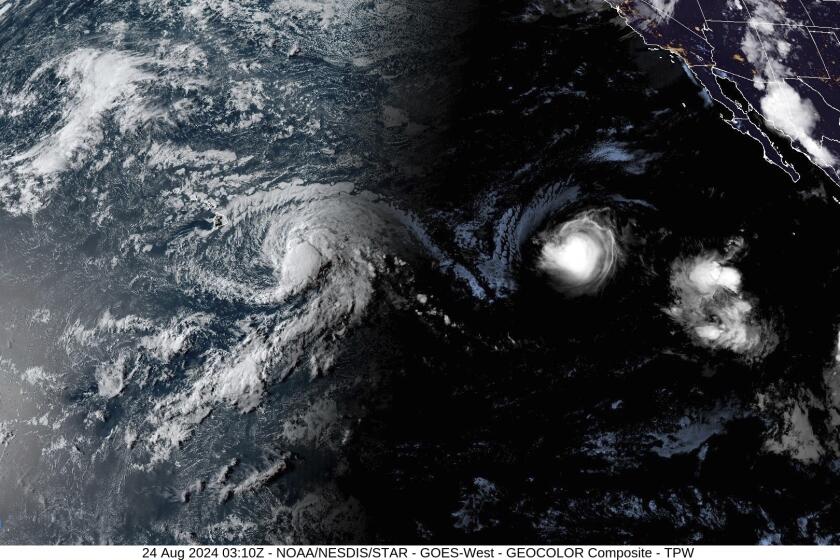ANALYSIS : Superior Weapons Give GIs Advantage in Ground War
Iraq has 4,000 tanks in Kuwait and southern Iraq, twice the number deployed by U.S.-led forces in the Persian Gulf, and it boasts similar advantages in numbers of artillery and troops.
By February, the opposing armies will be more evenly balanced, but the odds still will not favor a ground war to force Iraq out of Kuwait. According to a military rule of thumb, attackers should hold an advantage of 3 to 1 to have a reasonable chance of success.
Yet all signs point to a full-scale ground assault by U.S. and allied forces as the centerpiece of the Bush Administration’s military strategy, if war comes to the gulf. And the Administration appears confident of a quick and decisive victory.
Why is it not dissuaded by the numbers?
History is replete with cases in which smaller forces have won against larger numbers--Hitler’s defeat of France in the early days of World War II is one example--because of superior weaponry and other factors. A study of nine specific battles, in fact, showed attackers winning in nearly half the cases in which “the attacker is outnumbered by between 1 to 3 and 2 to 3,” according to a 1986 U.S. Army report.
Further, computer models of ground warfare support the Administration’s promise of an overwhelming victory. A weapon-by-weapon assessment by the U.S. Army of American and Soviet-made Iraqi equipment--from tanks to rifles--shows that the United States has a decisive edge in quality that would compensate for its numerical disadvantage.
The chief battlefield weapon is the tank, for example, and a U.S. M-1A1 tank is assessed as more than 30% better than an Iraqi T-72 tank because of its greater firepower, maneuverability and protective armor. Three M-1s are worth four T-72s. And, compared to older Soviet tanks in the Iraqi arsenal, the M-1’s advantage is even greater.
Similar technical superiority exists in most other weapon systems, according to the assessment. U.S. multiple-launch rocket systems have 12 times the effectiveness of Iraq’s 155-millimeter howitzer artillery. And in the key category of attack helicopters, the advantage is theoretically infinite since Iraq has none while the United States has more than 400.
When such assessments are factored into the opposing ground-combat units and the forces are pitted against each other in war games, the conclusion by Pentagon and many non-government experts seems to be the same: “We’d crush them,” said Joshua M. Epstein of the Brookings Institution.
Iraqi numbers, including its million-man army, simply should not be a problem, added Barry R. Posen of the Massachusetts Institute of Technology. “If anything, we might begin to address the ethical question of how much slaughter you want to inflict on his forces if war comes.”
There are doubters, nonetheless. However advanced the modeling techniques, all of the experts, including Epstein and Posen, warn that unknown and unpredictable events could turn the most modern technological projections into bloody catastrophe.
Chief among the worries of professional soldiers:
* Will the air war go as advertised? Probably yes, because air combat turns far more on the technical characteristics of weapons than does ground warfare, and both model-builders and professionals have concluded that U.S.-led air forces will seize control of the skies. But if that control does not translate into an effective advantage--if the Iraqis can absorb air strikes like the Vietnamese did during the Vietnam War, for instance, the ensuing ground war will go on longer and be far more costly, they fear.
* Will the U.S. all-volunteer, never-before-tested military hold up in combat? Again, probably yes. But in previous wars, U.S. forces have performed poorly at first, learned quickly, and then done very well. “We won’t have that kind of time to learn here,” warned a U.S. expert familiar with Pentagon concerns.
* Will U.S. military leadership, from generals down to platoon sergeants, be quick enough to exploit unexpected opportunities yet disciplined enough about following orders in the confusion that is called the “fog of war?” Impossible to know.
“Here’s a mundane but very real problem,” said retired Lt. Gen. William E. Odom. “M-1 tanks move 30 to 40 miles per hour over terrain, twice that fast on roads. Will their commanders read the maps fast enough? Even on our own test ranges, they get lost, double back, shoot at their own troops. Fratricide will be unavoidable. You just want to keep fratricide low.”
These great uncertainties have caused American generals to be “2,000% careful,” as one expert put it. The Pentagon’s decision to almost double the size of U.S. ground combat forces in Saudi Arabia by February reflects that care, as does the almost mordant comment of Gen. H. Norman Schwarzkopf, chief of U.S. forces in the Persian Gulf.
“I’m not one to go rushing into battle,” he said. “I’m not a Gen. Custer . . . I’m really not.”
Models have their flaws, but they are far better than “bean counting,” which is how the experts refer to simply adding up the numbers of troops and weapons on each side. “They don’t work perfectly,” one expert said, “but they’re all you have, really, that attempts to factor quality into the quantities.”
“Models have all the defects of big indexes, but they have the advantage of sweeping away detail,” Epstein explained. “They let you get your brain around the problem.”
Ground warfare equations were invented after World War I by a British meteorologist, Frederick William Lanchester, to predict the interaction and attrition of forces based largely on the technical characteristics of weapons and terrain.
In simple terms, models typically dealt with the question of how many casualties per hour would be suffered if X number of shells were fired per hour against Y number of troops, with Z the amount of their protection. The first side to lose a significant proportion of its force--between 10% and 30%--would break or surrender.
Lanchester’s models worked well when applied, retrospectively, to World War I and the American Civil War, both of which were essentially static, or “set piece” wars. But the approach falls apart when rapidly mobile forces are introduced, as occurred in World War II, when the shock effect of tank attacks produced psychological collapse that required entire units to be withdrawn from battle. And it did not work for Vietnam.
Modern ground-war modeling, which takes into account mobility and the movement of battle fronts, is based on assessments by the U.S. Army War Gaming Agency after Vietnam of the combat value and combat effectiveness of 10 types of weapons. (The distinction is that a tank is more valuable than a rifle on the battlefield, but some tanks are more effective than others.)
Virtually all weapons in the world are rated for effectiveness, based on their technical characteristics. The survey, once top-secret but made public several years ago, covered principally those weapons of the United States and the Soviet Union that were already in production or projected for manufacture by 1993.
The tank--”queen of the battlefield,” in chess terms--was arbitrarily made the standard.The U.S. M-60 tank was given an effectiveness rating of 1.0. When the M-1 was fielded in 1980, it was rated at 1.24. The M-1A1, with a 155-millimeter gun instead of a 105-millimeter gun, was rated 1.34.
Similar effectiveness ratings were determined for other weapons categories, from artillery to small arms. A rifle is valued at 1.0, a machine gun at 1.77, for example; a 155-millimeter howitzer at 1.02 and a MLRS rocket system at 1.16. The other categories include antitank weapons, mortars, armored reconnaissance vehicles, armored personnel carriers, infantry fighting vehicles, air defense weapons and attack helicopters.
The combat value, or relative weight, of the weapon categories were decided by a team of experienced battlefield commanders. Most valuable, they decided, are attack helicopters, with an average value of 109. Next are artillery (99), then tanks (94), scaling down to small arms (4).
When the number of weapons in a U.S. armored division is multiplied by these effectiveness ratings and their combat value, the resulting total--about 130,000--becomes the armored division equivalent (ADE). All other units, bigger or smaller, can be measured against this standard. A U.S. infantry division, for example, is worth 0.5 ADE, or half an armored division.
Epstein and his associate, Alf Hutter, calculate that all U.S.-led forces in Saudi Arabia will be valued at 17.6 ADEs by February, when the latest buildup is completed. Iraqi forces in Kuwait will be valued at 7.4 ADEs, and those in northern Kuwait and southern Iraq at 9.6 ADEs, according to their calculations.
This appears to place opposing forces roughly in balance, but in fact the Iraqi forces are widely dispersed in defense, offering a challenge of only 2.3 ADEs for U.S. forces in the “main attack sector.”
Epstein’s bottom line, based on his modeling, is an 18-day war. The first six days would be used for air strikes to establish control and soften up Iraqi ground forces. In the next six days, the ground attack, breakthrough and movement northward would take place. The final six days would be used to mop up. Casualties would be about 15,000 (with 25% dead), he said, although they could be as high as 22,000 or as low as 3,600.
Posen said that he believes such models understate the U.S. advantage because they do not reflect the better training, logistic supplies, command and control and other qualitative edges.
“We will have total control of the air,” he said, “and we know from Rommel (German Gen. Erwin Rommel, ‘the Desert Fox’ of World War II) what it’s like to operate in the desert when the enemy has complete control of the air: ‘like a savage against modern European troops.’ ”
U.S. forces will be able to concentrate at their intended attack point to reach a jump-off advantage of as much as 5 to 1, Posen said, because Iraqi artillery--the usual weapon to prevent such concentrations behind enemy lines--will be largely wiped out.
“We are very good at counter-battery fire,” he said, pointing to special radar to locate any Iraqi artillery batteries that could then be assaulted with massive, rapid-fire artillery weapons and the MLRS rocket systems. One MLRS volley of 12 rockets is supposed to have the same effect as 72 rounds of 155-millimeter howitzers.
“In just artillery alone, we figured we could deliver 500 tons of metal (artillery shells) on his positions in only one hour,” Posen said. “We astonished ourselves with that figure.
“So his numbers should not be a problem,” he concluded. “With our mass and our technology, it should be a pushover.”
So say the model-builders. But skeptics remain unconvinced.
“Models and modern analysis can do lots of things,” one experienced former officer said. “But they are not good at prediction, at telling you how fast you’ll move, how long the war will take, how many men you’ll lose.”
More to Read
Sign up for Essential California
The most important California stories and recommendations in your inbox every morning.
You may occasionally receive promotional content from the Los Angeles Times.






